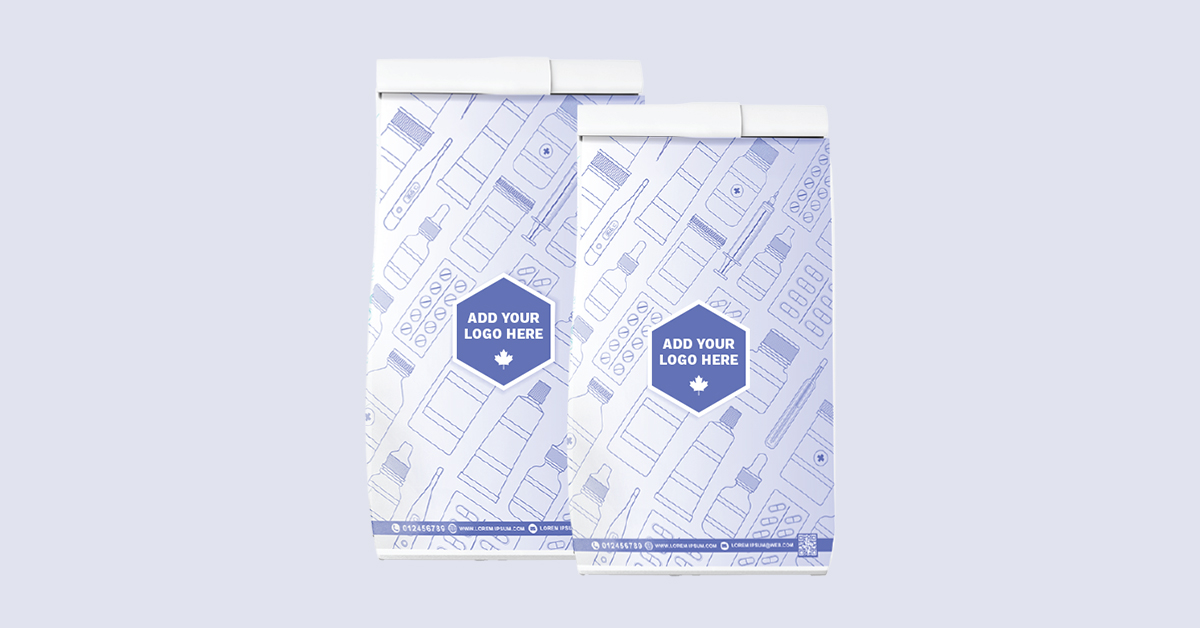Contact Us
or call us now 800.268.5620
or call us now 800.268.5620

The packaging industry is undergoing a notable shift, driven by increasing demands for sustainable packaging and a growing focus on environmental responsibility. Historical approaches to the packaging were shaped by availability, cost, and function. Today, there is increasing momentum toward eco-friendly materials and practices, particularly in the adoption of paper bag packaging.
Packaging materials and methods reflect the changing relationship between society, technology, and the environment. Reviewing this progression helps explain the attention currently given to sustainable paper bag packaging:
| Era | Packaging Trends |
| Pre-1900s | The centre of packaging solutions was directed towards natural, reusable materials (including cloth, wood, and glass) that aimed at multiple use. |
| 1900s– 1950s | Grocery and general retail began using paper bags commercially, along with the growing use of cardboard boxes. |
| 1950s–1980s | Ease of use and durability replaced paper bags with plastic as a material choice. Single-use plastic gained popularity. |
| 1990s–2000s | A more widely-known concern over the lifetime effects of plastic waste has generated more tries at recycling and initial steps in green packaging solutions. |
| 2010s– Present | A significant movement toward products like Kraft paper, recycled paperboard, and water-based inks; these materials feature strongly in discussions of sustainable packaging today. |
Many industries are currently switching to more eco-friendly packaging options, seeing how beneficial it is to them economically as well as ecologically.
The pharmaceutical market is changing towards the use of paper-based solutions for both over-the-counter (OTC) drugs and wellness products, avoiding excessive plastic blister packs and bags. The change not only helps to facilitate sustainability, but it also conforms to the regulatory push towards greener healthcare solutions.

Businesses in the QSR (quick service restaurants) category are opting for recyclable packaging for deliveries and takeaways. This marks their contribution to sustainable practices while meeting the interests of environmentally aware shoppers.

Retailers are re-strategizing packaging to support new consumer demand for sustainability. Minimalist branded paper bags are becoming increasingly popular as companies seek to reduce their use of plastic and convey a message of responsibility.
Attempting to minimize plastic usage, the food and beverage industry has switched to paper-based packaging in both their dine-in and takeout services. Many applaud the idea of thoughtful consumption. The emphasis is not only to reduce disposable products, but to use compostable and/or recycled paper bags to deliver food and purchase goods in-store.
There is a specific packaging waste associated with online retail. Making the transition to recyclable and recycled paper materials, e-commerce companies are already mitigating the criticism of shipping efficiency and environmental degradation, earning consumer confidence in regard to sustainable operations.
Supermarkets have been the biggest contributors of single-use packaging. Through the provision of recyclable and biodegradable groceries and produce paper bags, these stores collectively serve in the reduction of plastic pollution and general sustainability agendas.
Transitioning to paper-based and other sustainable packaging solutions provides tangible environmental, operational, and regulatory benefits.
Paper bags, especially those made from responsibly sourced and recycled fibers, are typically recyclable and biodegradable. This reduces pressure on landfills, conserves resources, and lowers pollution compared to conventional plastic alternatives.
Sustainable packaging allows companies to demonstrate leadership in environmental responsibility. When brands transparently communicate their approach and show measurable outcomes, it fosters trust among both consumers and business representatives.
Many governments are expanding regulations on single-use plastics, introducing taxes or bans and driving the shift toward readily recyclable options like paper. Companies adopting these measures position themselves for compliance and operational continuity as policy frameworks evolve.
Regulatory change remains a key catalyst in shaping packaging practices at scale.
Policymakers worldwide have enacted measures—such as bans and taxes—targeted at curbing single-use plastics. These shifts prompt organizations to adopt paper and other recyclable materials to remain compliant.
Tax incentives and certification schemes encourage businesses to pursue sustainable packaging innovation and transparency. Participation in such programs can bring operational benefits and help establish industry standards.
Atlantic Packaging Products has emerged as a leader in sustainable packaging solutions, emphasizing innovation and environmental stewardship. By integrating recyclable and compostable materials across their product lines, the company actively supports the shift toward a circular economy. Our commitment to transparency and collaboration with businesses ensures tailored solutions that meet both environmental goals and functional needs, setting a benchmark for the industry.
One of the offerings from Atlantic Packaging Products is their sustainable paper bag solutions. These paper bags are designed to replace single-use plastic bags, offering a recyclable and biodegradable alternative that minimizes environmental impact. Manufactured from responsibly sourced materials, they align with the principles of sustainability while maintaining durability and practicality for a variety of applications. Through continuous innovation and collaboration, Atlantic Packaging ensures that their paper bags not only meet industry standards but also support businesses in achieving their environmental objectives.
© 2025 Atlantic Packaging Products Ltd. All rights reserved.
Atlantic Packaging Products
We firmly believe that the internet should be available and accessible to anyone, and are committed to providing a website that is accessible to the widest possible audience, regardless of circumstance and ability.
To fulfill this, we aim to adhere as strictly as possible to the World Wide Web Consortium’s (W3C) Web Content Accessibility Guidelines 2.1 (WCAG 2.1) at the AA level. These guidelines explain how to make web content accessible to people with a wide array of disabilities. Complying with those guidelines helps us ensure that the website is accessible to all people: blind people, people with motor impairments, visual impairment, cognitive disabilities, and more.
This website utilizes various technologies that are meant to make it as accessible as possible at all times. We utilize an accessibility interface that allows persons with specific disabilities to adjust the website’s UI (user interface) and design it to their personal needs.
Additionally, the website utilizes an AI-based application that runs in the background and optimizes its accessibility level constantly. This application remediates the website’s HTML, adapts Its functionality and behavior for screen-readers used by the blind users, and for keyboard functions used by individuals with motor impairments.
If you’ve found a malfunction or have ideas for improvement, we’ll be happy to hear from you. You can reach out to the website’s operators by using the following email
Our website implements the ARIA attributes (Accessible Rich Internet Applications) technique, alongside various different behavioral changes, to ensure blind users visiting with screen-readers are able to read, comprehend, and enjoy the website’s functions. As soon as a user with a screen-reader enters your site, they immediately receive a prompt to enter the Screen-Reader Profile so they can browse and operate your site effectively. Here’s how our website covers some of the most important screen-reader requirements, alongside console screenshots of code examples:
Screen-reader optimization: we run a background process that learns the website’s components from top to bottom, to ensure ongoing compliance even when updating the website. In this process, we provide screen-readers with meaningful data using the ARIA set of attributes. For example, we provide accurate form labels; descriptions for actionable icons (social media icons, search icons, cart icons, etc.); validation guidance for form inputs; element roles such as buttons, menus, modal dialogues (popups), and others. Additionally, the background process scans all the website’s images and provides an accurate and meaningful image-object-recognition-based description as an ALT (alternate text) tag for images that are not described. It will also extract texts that are embedded within the image, using an OCR (optical character recognition) technology. To turn on screen-reader adjustments at any time, users need only to press the Alt+1 keyboard combination. Screen-reader users also get automatic announcements to turn the Screen-reader mode on as soon as they enter the website.
These adjustments are compatible with all popular screen readers, including JAWS and NVDA.
Keyboard navigation optimization: The background process also adjusts the website’s HTML, and adds various behaviors using JavaScript code to make the website operable by the keyboard. This includes the ability to navigate the website using the Tab and Shift+Tab keys, operate dropdowns with the arrow keys, close them with Esc, trigger buttons and links using the Enter key, navigate between radio and checkbox elements using the arrow keys, and fill them in with the Spacebar or Enter key.Additionally, keyboard users will find quick-navigation and content-skip menus, available at any time by clicking Alt+1, or as the first elements of the site while navigating with the keyboard. The background process also handles triggered popups by moving the keyboard focus towards them as soon as they appear, and not allow the focus drift outside it.
Users can also use shortcuts such as “M” (menus), “H” (headings), “F” (forms), “B” (buttons), and “G” (graphics) to jump to specific elements.
We aim to support the widest array of browsers and assistive technologies as possible, so our users can choose the best fitting tools for them, with as few limitations as possible. Therefore, we have worked very hard to be able to support all major systems that comprise over 95% of the user market share including Google Chrome, Mozilla Firefox, Apple Safari, Opera and Microsoft Edge, JAWS and NVDA (screen readers).
Despite our very best efforts to allow anybody to adjust the website to their needs. There may still be pages or sections that are not fully accessible, are in the process of becoming accessible, or are lacking an adequate technological solution to make them accessible. Still, we are continually improving our accessibility, adding, updating and improving its options and features, and developing and adopting new technologies. All this is meant to reach the optimal level of accessibility, following technological advancements. For any assistance, please reach out to
